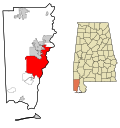Ashland Place Historic District | |
 | |
| Location | Mobile, Alabama |
|---|---|
| Area | 40 acres (16 ha) |
| Built | 1907 |
| Architect | Hutchisson, Clarence, Sr.; Et al. |
| Architectural style | Late 19th And 20th Century Revivals, Bungalow/Craftsman, Late Victorian |
| NRHP reference No. | 87000935 [1] |
| Added to NRHP | 23 June 1987 [1] [2] |
The Ashland Place Historic District is a historic district in the city of Mobile, Alabama, United States. The neighborhood gained its name from a Greek Revival antebellum house called Ashland that once stood on Lanier Avenue. Ashland was famous as the home of Augusta Evans Wilson. [3] The house burned in 1926. The Ashland Place Historic District was placed on the National Register of Historic Places on June 23, 1987. [1] It is roughly bounded by Spring Hill Avenue, Ryan Avenue, Old Shell Road, and Levert Avenue. [2] The district covers 400 acres (1.6 km2) and contains 93 contributing buildings. The majority of the buildings date to the early 20th century and cover a variety of historical architectural styles ranging from late Victorian to the Craftsman styles. [2]








